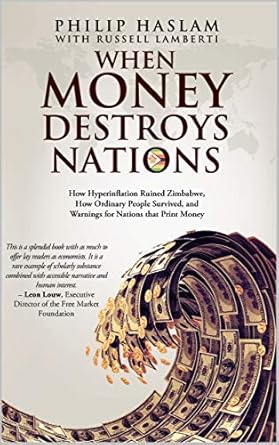Discover the gripping narrative of “When Money Destroys Nations: How Hyperinflation Ruined Zimbabwe.” This eye-opening book by Philip Haslam and Russell Lamberti delves into the catastrophic collapse of the Zimbabwean economy, driven by reckless money printing. It offers a detailed exploration of the dire consequences faced by ordinary Zimbabweans during the world’s second-highest hyperinflation, providing invaluable lessons for nations today.
With a compelling mix of personal stories and economic analysis, this insightful account warns against the dangers of inflationary policies that threaten financial stability. “When Money Destroys Nations” is not just a historical account; it’s a crucial guide for policymakers and citizens alike, highlighting the perils of pursuing illusory shortcuts to economic prosperity. Don’t miss this essential read that uncovers the stark realities of a nation in turmoil and the resilience of its people.
When Money Destroys Nations: How Hyperinflation Ruined Zimbabwe, How Ordinary People Survived, and Warnings for Nations that Print Money
Why This Book Stands Out?
- Real-Life Accounts: Provides gripping narratives of ordinary Zimbabweans who faced the harsh realities of hyperinflation, bringing a human perspective to economic theory.
- In-Depth Analysis: Offers a straightforward examination of the causes and consequences of Zimbabwe’s economic collapse, making complex economic issues accessible to a broad audience.
- Timely Warnings: Serves as a cautionary tale for nations considering reckless monetary policies, highlighting the broader implications of hyperinflation beyond Zimbabwe.
- Expert Endorsement: Praised by recognized authorities such as Professor Steve H. Hanke, adding credibility and weight to the authors’ insights and findings.
- Engaging Style: Combines academic rigor with engaging storytelling, ensuring readers remain captivated while gaining valuable knowledge.
- Lessons for Today: Emphasizes the relevance of Zimbabwe’s experiences for contemporary economic policies, making it a vital read for policymakers and citizens alike.
Personal Experience
Reading “When Money Destroys Nations” can evoke a myriad of emotions and reflections, particularly for those who have experienced economic uncertainty or witnessed the impacts of financial crises in their own lives. The gripping narrative of Zimbabwe’s hyperinflation and the resilience of its people offers relatable insights that resonate on a personal level.
- Understanding Economic Vulnerability: Readers may recognize parallels between Zimbabwe’s plight and their own experiences with economic instability, whether through job loss, inflation, or financial mismanagement in their countries.
- Empathy for Ordinary People: The stories of individuals navigating through adversity can spark empathy, allowing readers to connect with shared human experiences of struggle, resilience, and hope.
- Lessons on Financial Literacy: The book serves as a powerful reminder of the importance of understanding monetary policy and the potential consequences of government decisions, encouraging readers to be more informed citizens.
- Reflections on Personal Finance: It may inspire readers to evaluate their own financial decisions, consider the implications of debt, and prioritize sustainable practices in their personal lives.
- Awareness of Global Issues: Engaging with the content fosters a broader awareness of global economic challenges, prompting readers to think critically about their role in advocating for responsible governance and economic practices.
In essence, “When Money Destroys Nations” is not just a historical account; it is a powerful narrative that invites readers to reflect on their own lives and the world around them. The lessons from Zimbabwe’s experience serve as a cautionary tale, urging us all to heed the warnings of economic mismanagement and to foster resilience in our own communities.
Who Should Read This Book?
This book is an essential read for a diverse audience interested in understanding the complexities of economic policies and their real-world consequences. Here are the key groups who will find value in ‘When Money Destroys Nations’:
- Students and Scholars of Economics: Those studying economics will gain insights into the practical implications of hyperinflation and monetary policy failures.
- Policy Makers and Political Leaders: This book serves as a cautionary tale for those in positions of power, illustrating the dangers of reckless money printing.
- Investors and Financial Professionals: Understanding the historical context of hyperinflation can aid in making informed investment decisions in today’s economic climate.
- General Readers Interested in History: The gripping narrative provides a compelling look at a significant historical event, making it accessible for anyone interested in learning about Zimbabwe’s past.
- Activists and Advocates for Economic Reform: Readers involved in economic justice movements will find valuable lessons on the impact of economic policies on ordinary lives.
Overall, ‘When Money Destroys Nations’ not only educates but also serves as a dire warning for any nation considering similar economic strategies.
When Money Destroys Nations: How Hyperinflation Ruined Zimbabwe, How Ordinary People Survived, and Warnings for Nations that Print Money
Key Takeaways
Readers can expect to gain valuable insights and lessons from “When Money Destroys Nations,” including:
- Understanding Hyperinflation: A clear explanation of what hyperinflation is and how it can devastate an economy.
- Historical Context: An in-depth look at the rise and fall of the Zimbabwe dollar and the factors leading to its collapse.
- Real-Life Accounts: Inspiring and tragic stories of ordinary Zimbabweans who navigated the challenges of hyperinflation.
- Economic Warnings: Important lessons for nations that consider printing excessive money as a solution to economic problems.
- Political Implications: Insights into how political decisions can lead to economic ruin and the enrichment of elites at the expense of the public.
- Survival Strategies: Practical examples of how individuals and communities adapted to survive during extreme economic hardship.
- Global Relevance: A reminder that Zimbabwe’s experience serves as a cautionary tale for other countries facing similar temptations.
Final Thoughts
“When Money Destroys Nations” is a compelling exploration of Zimbabwe’s harrowing journey through hyperinflation, offering invaluable insights into the perils of reckless monetary policies. Authored by Philip Haslam and Russell Lamberti, this book not only details the catastrophic economic collapse but also highlights the resilience of ordinary citizens who endured unimaginable hardships. The narrative serves as a cautionary tale for nations worldwide, illustrating the broader consequences of printing money to resolve fiscal challenges.
- In-depth Analysis: The authors provide a thorough examination of the factors leading to Zimbabwe’s hyperinflation.
- Human Stories: Personal accounts of survival add a poignant layer to the economic narrative.
- Lessons for All: The book underscores the universal implications of hyperinflation for any country contemplating similar financial strategies.
- Accessible Writing: The engaging prose makes complex economic concepts understandable for all readers.
This book is not just an account of Zimbabwe’s past; it is a vital resource for anyone interested in economics, politics, or social justice. Don’t miss the opportunity to learn from this extraordinary story and apply its lessons to today’s global challenges. Purchase “When Money Destroys Nations” today!





